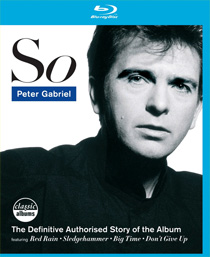When Peter Gabriel left Genesis in 1975 to pursue a solo career, he could have very well clung to his image and staged theatrical rock and roll shows. And though he did that to some extent, he also ventured out to establish an identity of his own. After four very distinctive, self-tilted albums, Gabriel found his niche not only as an adaptable singer and songwriter, but as a music video pioneer, promulgator of world music and political activist. In 1986, Gabriel released his fifth studio album So and it became a bona fide commercial success. To celebrate its 25th anniversary (or 26th if you’re keeping count), So has been buffed out, remastered and reissued. Meanwhile, the acclaimed Classic Albums series has issued Classic Albums: So on DVD and Blu-ray; this is where we get a deeper look at Gabriel and the making of his most popular and biggest-selling album.
Even though So does have a fair amount of pop serenity to it, Gabriel hardly abandoned his eclectic ways. Even the singer comments early on how “hits” were rare for him. But the album came together at Gabriel’s Ashcombe Studios where the singer and co-producer Daniel Lanois conspired to create So. “Sledgehammer,” which Gabriel says was not written intentionally as a commercial hit, but more out of his love for soul and R&B, rose in the charts largely on the strength of its companion video – which also receives lots of attention in the documentary.
The best thing about the stories behind the albums in the Classic Albums series is those little tidbits of newly discovered information. We learn “Don’t Give Up,” the tender duet with Kate Bush that underscores Gabriel’s sensitivity to the plight of the working class, was originally offered to Dolly Parton. Can you imagine how different that would have sounded? Elsewhere, bassist Larry Klein talks about his contribution to “Mercy Street,” written for Anne Sexton, the self-destructive poet who tragically took her own life in 1974.
Further commentary from Gabriel, Lanois, engineer Kevin Killen, and musicians Jerry Marotta, Laurie Anderson, Tony Levin and Manu Katché keep the story going. David Fricke, Rolling Stone contributor and a regular in these types of documentaries, weighs in with his theories as to why the first four Peter Gabriel solo albums were untitled and why the running order of songs on the So CD is better than the running order on the vinyl edition. Trivia aside, we can surmise from watching Classic Albums: So that the album was most definitely a game-changer in Peter Gabriel’s career.
~ Shawn Perry




















